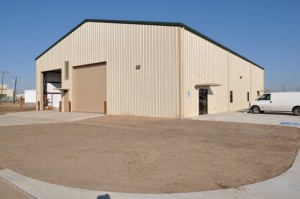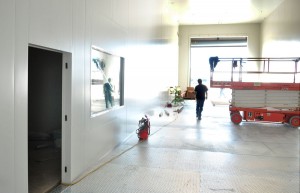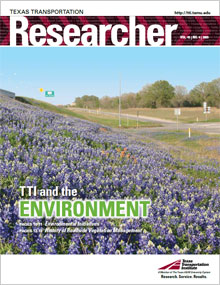
At the Texas A&M University Riverside Campus in Bryan, Texas, workers have completed the finishing touches on another in a line of world-class testing centers offered by the Texas Transportation Institute (TTI) to its sponsors.
The Drive-In Environmental Research Chamber, which opens in January 2010, is the largest of its kind in the country. The facility consists of a temperature- and humidity-controlled, 75-by-22-by-22-foot chamber housed in a building that also contains a conference room, offices, control room and vehicle preparation area. It’s large enough that an 18-wheeler with trailer or a bus can easily drive into the facility.
The development of the chamber resulted from competitive grant awards to TTI from the U.S. Environmental Protection Agency (EPA) and the Houston Advanced Research Center (HARC), with additional funding provided by The Texas A&M University System and TTI.
According to TTI Director of the Center for Air Quality Studies Joe Zietsman, the idea for constructing the testing center came when TTI was awarded a project from the EPA to develop and apply a verification protocol for testing onboard idle reduction technologies for semi trucks.

“The closest environmental testing facility large enough to conduct this research was located in Reno, Nevada,” says Zietsman. “When we began to look at costs in terms of chamber rental fees, travel and housing researchers in Reno over a length of time, we realized that it would make sense over the long term to develop our own test chamber.”
Research Opportunities
The chamber offers numerous opportunities for emissions and fuel consumption testing of various types of vehicles and engines, as well as many other products for their durability under severe temperature, humidity and weather-like conditions. A key capability will be to measure “cold starts,” which is a critical aspect of vehicle emissions testing.
Some of the other testing opportunities include:
- emissions and fuel consumption from idling cars, trucks and buses, including cold starts;
- emissions and fuel consumption from construction equipment;
- emissions and fuel consumption from a broad range of engines, including generators;
- hybrid technologies;
- clean fuels;
- vehicle components such as air conditioners, heaters and auxiliary power units;
- infiltration of pollutants into vehicles;
- emissions reduction technologies;
- lubricants and oils;
- insulation materials;
- ability of plant and other materials to absorb emissions;
- durability of equipment under severe weather conditions;
- impact of weather on the strength of construction components such as steel and concrete; and
- agricultural and food products.
First Project
The first project for the facility is testing auxiliary power units (APUs) for tractor-trailer trucks. APUs work as an alternate small engine of sorts that allows truck drivers to shut off their main engines, yet still run their cab necessities such as air conditioning, heating and other electrical appliances.
“With the hundreds of thousands of trucks traveling through the United States every day and the requirement for drivers to rest 10 hours for every 14 hours of driving, the amount of emissions and fuel wasted due to extended idling of these large trucks is mind boggling,” says Zietsman.
Although APUs seem like a perfect solution to idling engines, no standard exists that accurately shows the decrease in pollutants and fuel wastage when they are running.
“There are numerous manufacturers of APUs, but no standards exist,” says Zietsman. “If we can develop a standard that tells potential buyers the emissions output, fuel consumption and power usage of a particular APU, then they can compare it with the other available models and choose the one that best fits their needs. These types of tests must be performed in a humidity- and temperature-controlled chamber to ensure consistency between tests and accuracy of results. Having the chamber will allow us to do that.”
The size and versatility of the environmental chamber has Zietsman and other researchers excited about the future of air quality research at TTI.
“It will significantly expand our program and will put TTI on the map with regards to emissions and other environmental testing,” says Zietsman.
